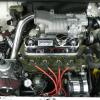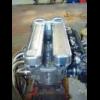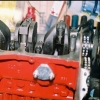
Compression Ratio Calculations
#1

Posted 10 November 2011 - 12:30 AM
1. Measure the average distance from piston top to block deck level with the pistons at TDC. Take the average for all 4 pistons.
2. Calculate the capacity of this volume (Call it ‘A’)
For 0.010” piston top to block deck this capacity will be:
Standard bore at 1275 cc = 0.99 cc
At +0.020” overbore = 1.01 cc
At +0.030” overbore = 1.02 cc
At +0.0402 overbore = 1.025 cc
At +0.060” overbore = 1.04 cc
3. Measure the volume of the dish in the top of the piston using the 5-cc syringe with clean water. With Hepolite 20250, 20251 & 20253 pistons this is 8.3 cc.
Call this ‘B’
4. Set the head up to be absolutely level using a spirit level. Measure the combustion chamber volume in the head using the syringe and clean water. Do this for a couple of chambers and take the average. Call this ‘C’
5. There is a volume in the head gasket area and we’ll make an assumption here that with the average gasket, say a BK450, it’s 4 cc. Call this ‘D’
6. There is the ‘ring land volume’. That’s the volume down the side of the piston to the top of the top ring. Allow 0.75 cc for this. Call it ‘E’.
7. Now divide the actual swept volume of your engine by 4 to get the swept volume per cylinder. Call this the swept volume ‘SV’
For a standard 1275 cc = 318.75 cc
At +0.020” overbore, i.e. 1293 cc = 323.25 cc
At +0.040” i.e. 1310 cc = 327.5 cc
At +0.060” i.e. 1330 cc = 332.5 cc
8. Add all the unswept volumes together i.e. A+B+C+D+E.
Call this the Total Unswept Volume ‘UV’
9. The Comp Ratio (CR) = (SV+UV) divided by UV
So, if you have a standard bore 1275 cc engine with the SV = 318,75
And if the total of the other volumes, the total unswept vol. UV =, say, 36 cc,
The CR = (318.75 + 36) divided by 36
= 354.75 / 36 = 9.85 to 1
However, if that is not the CR you want, you have to work backwards to calculate what the combustion chamber volume in the head should be.
Say you have the figures we just used, but you want the CR to be 10.4 to 1.
The formula to work out what the UV should be is:
SV divided by (CR-1) = UV
So, in the case we are using:
UV = 318.75/(10.4 – 1) = 318.75 divided by 9.4. = 33.9 cc
Add A+B+D+E, as established earlier and subtract this from the new figure for UV, in this case subtract it from 33.9. The resulting figure is the actual volume you need each combustion chamber to be.
Using the syringe again, after setting the head up to be absolutely level, put EXACTLY this amount of water into a combustion chamber.
The distance from the head face to the surface of the water is the amount to be skimmed from the head. To measure this I usually put a steel ruler across the head above the chamber and measure down to the water surface with a digital vernier, subtracting the thickness of he ruler afterwards. In practice, this is the most difficult dimension to measure as the water has a ‘meniscus’ which sort-of ‘reaches up’ to the bottom of the vernier calliper. You have to make a judgement on this, but don’t be put off, it is not that hard.
Once the head is skimmed as necessary you just fit it and your CR is correct. Remember if you are increasing the CR you will need to check and adjust the timing.
#2

Posted 10 November 2011 - 12:35 AM
Jake
#3

Posted 10 November 2011 - 09:42 AM
#4

Posted 10 November 2011 - 02:31 PM
I'd prefer 1 sticky which had relevant cross referenced links to FAQs. There is a great wealth of FAQs which are already relevant but I don't think people see them. I'd drop the 1380 and toque wrench and move them to FAQs....
Just a thought....
Charlie
#5

Posted 10 November 2011 - 03:23 PM
#6

Posted 10 November 2011 - 05:54 PM
#7

Posted 10 November 2011 - 06:16 PM
#8

Posted 10 November 2011 - 06:23 PM
there is a really usefull free app for the iphone on itunes store . that puts the std amounts in then you can adjust it from there .. no ore adding things up really worth a look
just having a look for it now but cant find it. what is it called?
Thanks
Liam
#9

Posted 10 November 2011 - 06:26 PM
there is a really usefull free app for the iphone on itunes store . that puts the std amounts in then you can adjust it from there .. no ore adding things up really worth a look
just having a look for it now but cant find it. what is it called?
Thanks
Liam
Found it. Its called carCal and is 69p in the UK
#10

Posted 10 November 2011 - 07:14 PM
#11

Posted 16 May 2014 - 12:35 PM
I wonder if you add washing up liquid to the water to lower the surface tension of the water you can eliminate most of the meniscus and make it easier to 'best guess'?
#12

Posted 25 September 2014 - 01:32 PM
or you could just find a calc on google for free
Like these ...
http://www.csgnetwor...m/compcalc.html
http://www.gtsparkpl...pRatioCalc.html
![]()
#13

Posted 25 September 2014 - 02:47 PM
#14

Posted 25 September 2014 - 04:55 PM
Is there any point calculating 'dynamic' compression ratios for Minis? There may be some value in knowing the dynamic compression if you are tuning two-strokes, but I don't see the benefit for 4 strokes.
All of the advice given on this forum is for static compression ratios,using dynamic would just complicate matters.
#15

Posted 25 September 2014 - 07:45 PM
Of course it is an important thing to consider when building a 4 stroke engine, infact when you change the CR of your 940 head is to alter the dynamic compression from say, 160-170 psi to 210-220 psi because you were fitting a long duration camshaft.
Dynamic compression is the combination that makes the engine power, not the static CR alone.
Its mainly depending on stroke, bore and the camshaft, ie the reason why long duration camshafts need an higher CR to restore dynamic compression. Exhaust and inlet will play their role too.
But yes, such things would add complications on a generic mini forum.
I know some might not agree but at the end of the day you're a bit 'limited' when working on the A series engine to the point that some modifications can be described as a magic formula (ie kent 286 - 11/12:1 CR).
When you get your teeth onto more exotic modifications, then you need to know a bit more about whats behind those data, and chasing a good dynamic compression will be important.
1 user(s) are reading this topic
0 members, 1 guests, 0 anonymous users





















